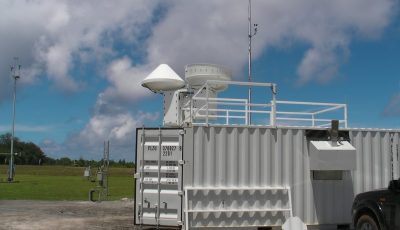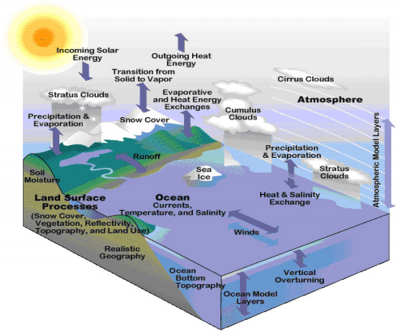“Engage with data in useful ways,” says NASA veteran

Earth system modeler Anthony D. “Tony” Del Genio is a three-decade NASA veteran. Away from the job, he is an avid fan of “Doctor Who,” and a wine enthusiast who builds vacations around vineyards. But you won’t find him away from the job much.
From his office at NASA’s Manhattan-based Goddard Institute for Space Studies (GISS), Del Genio works on improving the GISS General Circulation ModelE, scouring observation sites for new data, and (as head of a special group) applying earth system models to simulate climate and weather on exoplanets.
Over the years a lot of his work has touched on two programs funded by the U.S. Department of Energy (DOE): the Atmospheric Radiation Measurement (ARM) Climate Research Facility, which has gathered, processed, and archived atmospheric data since 1992; and the Atmospheric System Research program, the onetime DOE aerosols-focused Atmospheric Science Program that in 2010 expanded to assume ARM’s science role.
Taken together, says Del Genio, the two programs “have been unique contributors to the science—and an example of how we in this country have been able to exert leadership in moving science forward.”
As an earth system modeler, he uses ARM data to constrain model parameterizations of clouds and especially convection. Del Genio points to his Section 4 of a monograph on how ARM data impacted the GISS model—in particular data from ARM’s Southern Great Plains (SGP) atmospheric observatory regarding low-cloud feedbacks, cloud phase, convective downdrafts and entrainment, and vertical velocities.
“During the early years, we were one of the first groups to use ARM data at the SGP to actually infer something about a cloud feedback,” he says, “specifically how the optical thickness of low-level clouds responds to changes in temperature.”
Into the Clouds

Del Genio has used ARM data to understand convective clouds and cloud feedback in new ways. As the atmosphere changes over the 21st century, will it be cloudier or clearer? Will clouds change optical thickness, and therefore the way they reflect sunlight?
“There are a lot of things you have to get right” in a model that makes predictions many decades out, he says. “There are a lot of things to get wrong.”
Over decades of doing science, says Del Genio, “the hardest thing to do is engage with data in useful ways”—an insight he sees as his chief legacy. “I was one of the early adaptors to the idea that ARM data really did have something to teach us in ‘modeling land.’ ”
A sample of papers bears out his embrace of the data. Using ARM data from the western Pacific in a 2006 paper, for instance, he helped lead author Michael Jensen puzzle out why a long-neglected cloud type, cumulus congestus, even exists. These clouds represent a middle ground between puffy fair-weather cumulus clouds and the heavier and higher cumulonimbus storm clouds that produce a lot of rain.
Not long after, Del Genio and his modeling colleagues looked at data from several ARM field campaigns, including the Tropical Warm Pool-International Cloud Experiment (TWP-ICE), which spurred a paper on the properties of convective updrafts. That study, he says, was “one of the first attempts to evaluate convective vertical velocity in a climate model.”
Today, he adds, “ARM is really the world leader in vertical velocity retrievals.”
In 2010, the same data set helped Del Genio and co-authors of another paper understand the transition from shallow to deep convection—“another thing climate models have a hard time with,” he says.
More recently, he and others tapped data from the ARM MJO (Madden-Julian Oscillation) Investigation Experiment on Gan Island (AMIE-Gan) in the Maldives to develop and improve a parameterization of convective downdraft cold pools.
“Cold pools are the things you experience when a thunderstorm rolls by and before it gets to you as a sudden rush of wind and a drop in temperature,” says Del Genio. Cold pools are important for earth system models. Spreading cold air lifts warm humid air, spawns new convection, and allows the storm to persist.
In a 2015 study, Del Genio and his co-authors combined AMIE-Gan with satellite data and their in-house atmospheric general circulation model to show how introducing cold pools can improve how scientists model the Madden-Julian Oscillation, a slow-moving disturbance in the tropics that most models do not simulate.
Modeling Cloud Reality

Despite his intimacy with cloud data and modeling cloud feedback, Del Genio makes a point of staying behind his computer.
“The observers have always told me that I need to go out on a campaign sometime to see real clouds,” he says. “I tell them in return that I see real clouds close up every time I fly to a meeting.”
Early in ARM history, however, Del Genio spent a night at the SGP to watch field researchers running the Raman lidar. “We were in a trailer and a pretty good storm rolled in, and I was terrified,” he recounts, adding that the punchline was a 4 a.m. drive over unmarked roads and through cornfields. “That cured me of ever wanting to go out in the field.”
Del Genio prefers a computer atmosphere divided into the 3D grids modelers use, 50 to 100 kilometers on a side, in search of “something important and fundamental about how the atmosphere works,” he says. “Our challenges are in that box.”
Clouds are important because they can “amplify or moderate predicted changes,” says Del Genio. “In models, clouds are one of the two biggest uncertainties.” (The other is aerosols, like sulfate, sea salt, organic carbon, and dust.)
One advance in cloud modeling in the past 20 years, he says, is the now-common accounting for updraft speeds, which loft ice crystals and other particles into the air to form clouds. Vertical velocities and how to infer their effect over a large grid box is one of Del Genio’s specialties.
ARM was “in the forefront” in measuring vertical velocity, he says, and among the first to measure clouds in detail, from bottom to top.
Circuitous Paths
Del Genio was born in Manhattan, and he enjoyed a boyhood in the Bronx that included frequent visits to the Museum of Natural History and Hayden Planetarium.
At Cornell University, one of his undergraduate engineering professors studied planets, “and I found out I actually could do that for a career,” says Del Genio. That inspiration took him to graduate school at the University of California, Los Angeles to pursue a doctorate in planetary geophysics.
But a test at the end of his first year showed an aptitude for planetary atmospheres more than plate tectonics or mantle convection. So another shift in plans led him to more and more graduate classes in meteorology, to his first lessons in cloud parameterization, and to brushes with the giants of the day in global earth system models and tropical meteorology, including Akio Arakawa and the late Michio Yanai.
After getting his PhD, Del Genio went to GISS as a postdoc to analyze data from the Pioneer Venus mission. But right around then, atmospheric scientist James Hansen was making the shift from planetary science and needed someone to work on convection for the GISS GCM.
“Since I had taken Arakawa’s course, I thought it would be an easy thing to do,” says Del Genio. “Thirty years later, I’m still trying to get it right.”
# # #
This work was supported by the U.S. Department of Energy’s Office of Science, Office of Biological and Environmental Research as part of the Atmospheric System Research Program.

